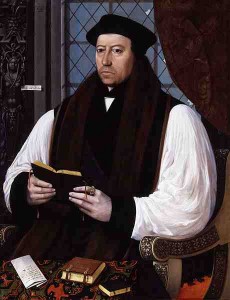 I always find it odd at this time of year that I spend three weeks counting down to Anne Boleyn’s execution in 1536 and then suddenly have to shift gear and go back to the events surrounding her coronation in 1533! What very different years and only three years apart.
I always find it odd at this time of year that I spend three weeks counting down to Anne Boleyn’s execution in 1536 and then suddenly have to shift gear and go back to the events surrounding her coronation in 1533! What very different years and only three years apart.
On 23rd May 1533, Archbishop Thomas Cranmer declared the sentence of the special court that had met at Dunstable Priory in Bedfordshire to examine Henry VIII’s case for an annulment of his first marriage. Convocation had given its ruling on 5th April 1533, stating that the Pope had no power to dispense in the case of a man marrying his brother’s widow, and that it was contrary to God’s law, and that ruling had led to Cranmer being authorised to set up this special trial.
Here is the record of the sentence of the Dunstable Priory court:
“My lord of Canterbury gave sentence this day at 11 o’clock in the great cause of matrimony; has declared it to be against the law of God, and has divorced the King from the noble lady Katharine. He has used himself in this matter very honorably, and all who have been sent hither on the King’s behalf have acted diligently and towardly. Sentence shall be given for the King’s second contract of matrimony before the Feast of Pentecost. The process is partly devised. 23 May.”1
Cranmer also wrote to the King, informing him personally of the sentence and the fact that his first marriage was over:
“Notification of the sentence of divorce between Hen. VIII. and Katharine of Arragon pronounced by archbishop Cranmer. Dated in the monastery of Dunstable, 23 May 1533. Present, Gervase prior of the said monastery, Simon Haynes, S.T.P., John Newman, M.A., and others.
The matrimony between the King and the lady Katharine being dissolved by sufficient authority, all pactions made for the same marriage are also dissolved and of none effect. That is, the jointure shall return again to the King’s use, and the money paid to him by her friends shall be repaid to her.
The matrimony being dissolved, the lady Katharine shall return to the commodity and profits of the first matrimony, and the pactions of the same, made with prince Arthur, and shall enjoy the jointure assigned to her thereby, notwithstanding any quittance or renunciation made in the second pact. For as these renunciations were agreed unto for a sure trust and hope to enjoy the commodities and pactions of the second marriage, which now she cannot enjoy, unless without fault she should be deprived of both, equity and right restore her to the first. This, we think, by our poor learning, to be according both to canon and civil law, unless there are any other treaties and pactions which we have not seen.
For the more clear declaration hereof, we think that when a matrimony is dissolved, if there is no paction of a further bond, then by law the money paid by the woman or her friends shall be restored to her, and the jointure return to the man and his heirs. In this case there is an especial pact that she shall enjoy her jointure durante vita, so that the said jointure is due to her by the pact, and the money paid by her and her friends by the law.”2
On 28th May 1533, Cranmer proclaimed the validity of Henry VIII’s marriage to Anne Boleyn after a special enquiry at Lambeth Palace.
Notes and Sources
- Letters and Papers, Foreign and Domestic, Henry VIII, Volume VI, 525, Letter from John Tregonwell to Cromwell, 23rd May 1533. Note: Thomas Bedyll, in a letter to Cromwell, states that the sentence was declared at 10am, rather than at 11am (LP vi.526).
- Ibid., 529.